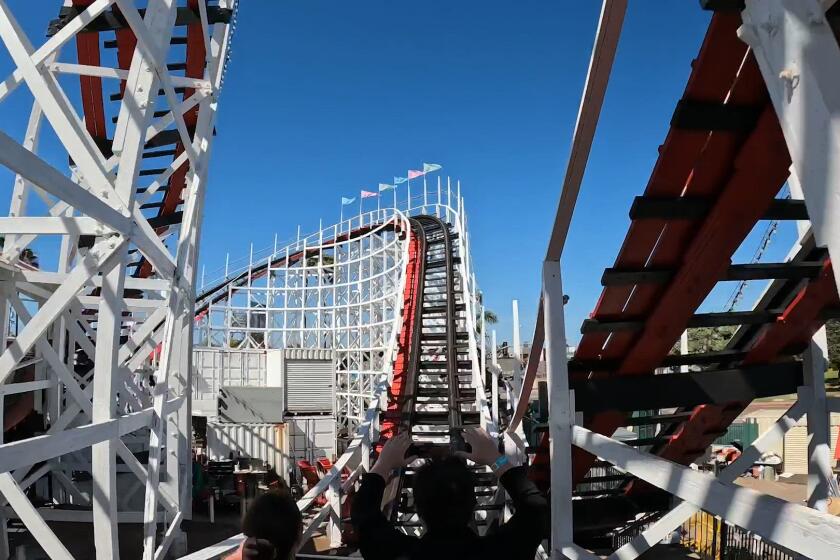More 55-plus workers delaying retirement, but how hard is it to get a job?

With a master’s degree in computer science and 30 years experience working for technology companies, Tom Middleton had little doubt he would soon find new employment after losing his job a decade ago as a software engineering manager at San Diego’s Kyocera.
How wrong he was.
After two years of submitting more than 300 applications for tech jobs, with only an occasional face-to-face interview, the then 59-year-old Middleton became convinced his age was a hindrance. He would hear feedback like “You’re overqualified” and “We can’t pay you what you’re used to.”
As money grew tighter, house payments were missed and 401(k) savings were exhausted, he took minimum wage jobs at Target and Walmart and tried his hand at income tax preparation. On a whim, he applied for a job as a bus driver — and was hired, now earning less than half his once six-figure salary.
“I had some days where I just wanted to crawl in a hole,” Middleton, 66, said of his job search. “I thought I’d be a bargain to someone but they didn’t see it that way. I understand now how the world works and it’s not to the benefit of older people.”
As a steadily growing share of baby boomers are opting to work well into their retirement years compared to past generations, the challenges of remaining employed or re-entering the workforce at an older age, even in today’s tight labor market, haven’t necessarily eased.
Whether provable or not, perceptions of ageism in hiring persist, as evidenced by recent surveys in which a sizable share of workers report having experienced or witnessed age discrimination.
And even as Labor Department data show more individuals 55 and older are employed than ever before and have a lower jobless rate — 3.1 percent compared with 3.9 percent for all workers — they remain out of work longer than their younger peers when they lose a job. Their hourly pay also starts to decline as they enter their 60s, regardless of how much education they have.
“We are living longer. We are living healthier. We want to work,” said Susan Weinstock, vice president of financial resiliency for the AARP. “We have this labor shortage, and we hear about the skills shortage. Older workers can fill those needs if employers will open themselves up to the idea that an older worker could be exactly what they need. Don’t think only about the stereotypes but about the individual people.”
RELATED: Why we wrote about older workers and jobs
Tim Driver, CEO of the 12-year-old job search site, RetirementJobs.com, said he was motivated to start the company, in part, after his father, then in his 60s, lost his bank job and was subsequently replaced by someone 10 years younger.
“I thought this wasn’t right and wanted to take it on not just as a business but to pursue a passion around ageism in the workplace,” said Driver, formerly of AOL and salary.com.
Since starting the site, Driver says he is buoyed by the high renewal rate among the 7,200 employers who have posted job openings on the site — more than 160,000, which are refreshed daily. The company also has certified about 100 larger employers, from Home Depot and Marriott International to Scripps Health, as age-friendly, Driver says.
“The listings are evidence there’s interest in older workers and particularly in the labor cycle we’re in where there’s more demand than ever,” said Driver. “But that doesn’t mean there isn’t a problem in America where employers believe older workers are slow, long in the tooth, not up to date on technology, and more expensive.”
Why work longer?
Changing demographics and compensation for older Americans have been upending the retirement landscape since the mid- to late 1990s.
In a reversal of a decades-long trend toward earlier retirement, 55-plus workers made up 22.4 percent of the U.S. workforce in 2016, up from just 12 percent 20 years earlier, according to the U.S. Bureau of Labor Statistics. By 2026, when baby boomers will have reached ages 62 to 80, that share is expected to rise to 25 percent.
Workforce participation also has risen sharply, with about 40 percent of people ages 55 or older either working or actively looking for work today, compared with 30 percent in 1996. A survey last year by the Transamerica Center for Retirement Studies found that more than half of those queried said they plan to work past age 65 or do not plan to retire.
Economists offer multiple theories about what is driving people to work longer, including improving health, higher education and a shift toward less physically demanding jobs.
The gradual phaseout of traditional employer pensions and a corresponding rise in more volatile 401(k) plans have also discouraged earlier retirements. At the same time, an increase in the Social Security full retirement age (now 66 and rising) has induced more people to stay in the workforce longer by rewarding them with higher monthly payments.
“There is a whole set of people who have never really recovered from the Great Recession,” said Weinstock of AARP. “If your retirement accounts took a hit at that time, it has only been 10 years, and it takes a lifetime to build up those retirement accounts.”
Workers 55 and older have been the fastest growing segment of the U.S. labor force since 1996, and that trend is expected to continue through 2026, according to the Bureau of Labor Statistics. At the same time, the growth rates for younger age groups aren’t projected to increase much over the next decade.
As much as the need for financial stability is pushing the retirement age higher, there are some people who simply like their jobs and aren’t ready to stop working, says Gary Burtless, a senior fellow in economic studies with the Brookings Institution.
“Just look at the kind of people who, even in their 80s, delayed their retirement. They have PhD’s, graduate degrees, there’s just a bigger bunch of baby boomers who have those credentials than previous generations,” he said.
“Yes, some of this (working longer) is because of financial privation, but for a lot of people, they like to work and understand the financial payoffs for doing so.”
Longer stretches of unemployment
Susan Arth, 63, has worked as a career counselor for more than 15 years, including most recently working part time for online outplacement website Careerminds and at Palomar College. She also operates her own consulting business.
In need of full-time work, she recently applied for a staff development position at a local startup after her hours were cut at Palomar. During a phone interview, she was asked how she could relate to the startup’s millennial workforce because of her age.
Arth had never disclosed how old she was, but she believes the human resources representative figured it out from her LinkedIn profile.
“Staff development is about the individual, not me,” said Arth, who has been searching for work since June. “But the progress of this position stopped at that point.”
She applied for one other career counseling job where she believes her age blocked her from getting an interview. As weeks turn into months, Arth has a “sinking feeling that I will not be able to have the career I am capable of and still want.”
As Arth quickly learned, finding work at an older age can be a frustratingly long process. On average, older workers stay unemployed longer than younger workers — about 37 weeks for people 55-plus compared with 25 weeks for workers ages 35 to 44, according to 2017 Bureau of Labor Statistics data.
Wage data assembled by the Federal Reserve Bank of Atlanta also shows average hourly pay for full-time workers starting to decline after age 60 across all education groups. Those statistics, though, are only for full-time employees and therefore don’t reflect the part-time work many older workers typically take, either by choice or necessity.
After 35 years in the construction industry, Dave Sapper, now 64, said it felt like a “punch in the gut” when he lost his highly paid management job as part of a downsizing move seven years ago.
Recognizing he would have to settle for pay well below his previous six-figure salary, he spent nearly a year looking for work before taking a job he never could have envisioned for himself.
For the last six years, Sapper has been a caravan driver for San Diego Zoo Safari Park, escorting visitors on two-hour tours that include close-up views of giraffes, rhinos and antelopes. Since joining the park, he has worked his way up to nearly 40 hours a week, earning $45,000 to $50,000 a year, he said.
Sapper acknowledges that his wife’s job as a school administrator allowed him to take a significant cut in pay, but he also says working at Safari Park has meant much less stress in his life.
“There was a time where I had said ‘Dave you might have to get that job at Target or something like that,’” Sapper recalls of his job search. “But with this job, I can now finally sleep at night and go to work happy and not be walking through the door dreading how am I going to make up for a half-million dollar overrun on a construction job.”
Ellyn Terry, economic policy specialist with the Federal Reserve Bank of Atlanta, surmises that one reason for the decrease in pay that some workers like Sapper see as they age may have to do with reduced productivity.
“There’s economic theory that says prime productivity declines close to the end of our careers,” she said. “And productivity is generally associated with wages; that is, the more you can produce the more you will get paid. Lower wages among older individuals may also reflect people switching to less intensive jobs.”
She is less convinced, though, that the data suggests age discrimination.
“An economist would argue that age discrimination should not exist, that when an employer wants the best person at the best price they’re not going to willy-nilly use age unless it’s related to something else correlated with worker productivity and they have nothing else to go on,” Terry said. “It’s probably not them being ageist.”
Proving age discrimination is tough
Greg Locke, 60, says he saw signs of bias while looking for work recently. After 21 years in the Marines, Locke earned a master’s degree in business management from San Diego State University and started a second career working for the County of San Diego in the early 2000s.
In June of last year, he retired as real estate telecommunications development project manager, took a few months off and then began looking for work again.
During a few of the six interviews he had, Locke said he was asked how he would interact with younger workers.
“I thought it was odd, and I have to wonder if younger workers were also asked how they would interact with older workers,” he said.
Locke eventually landed a job with a company that didn’t ask that question. He was hired as project manager for a private-sector firm that handles the government permitting process for small cellular broadcasting devices throughout San Diego.
“When I got out of the Marine Corps and got my master’s, I took some human resources graduate classes — so what you ask and do not ask in interviews,” he said. “I guess the observation I have, without crying a sea of tears, is there’s subtle discrimination for older folks going back into the workforce.”
Proving it, though, is difficult, especially so in instances where someone does not get hired for a job and age bias is the suspected reason.
Often cited as evidence that age discrimination does indeed exist is research conducted by a trio of economists who in 2015 sent out some 40,000 applications with fictitious resumes for about 13,000 largely low-skilled positions, such as retail sales clerks, janitors and administrative assistants. The resumes were nearly identical except for age and gender.
It turned out that callback rates were higher among younger applicants than their older counterparts, providing “compelling evidence that older workers experience age discrimination in hiring in the lower-skilled types of jobs the experiment covers,” the authors said.
Instances of age discrimination were most noticeable among older women, said co-author David Neumark, economics professor at UC Irvine.
Still, Neumark acknowledges that proof of discrimination remains elusive, probably more so during a healthy economy.
“My point is simply, it’s complicated,” Neumark said. “It’s better to be an older worker now than it was in 2010, and it’s better to be a black worker and an ex-felon because employers have fewer workers to choose from to hire. But it’s about the employment cycle, so right now it’s a little easier for these workers finding work but we’re at the end of a very long recovery.”
Nonetheless, there remains a strong perception among the graying workforce that their age is working against them.
A 2017 survey commissioned by AARP found that three in five workers over age 45 — or 61 percent — have either experienced or seen age discrimination in the workplace. In a similar poll by RetirementJobs.com, 94 percent of job seekers said that age bias in the job search is a fact of life in the workplace.
Laurie McCann, senior attorney with the AARP Foundation, says employers these days are savvy enough to “not leave the smoking gun around” that would clearly show age discrimination, but that doesn’t mean there aren’t more subtle instances of ageism in the hiring process.
“Some indications are asking that people be recent graduates. We’re also seeing some jobs where people have to be a digital native, which is someone who grew up using the Internet,” McCann said.
A 61-year-old San Diego man who lost his job last November after 14 years, said he saw subtle indications of ageism in the post-layoff counseling he received from an employment services agency. He requested anonymity because of concerns surrounding his employment search in San Diego.
He was advised to edit his work experience on his resume, restricting it to the most recent jobs, and was told to eliminate dates on his resume – even the year he graduated from college.
That is not so easy to do, though, when applying online for a job, says McCann.
“We also see online job applications where you can’t submit it unless you put on a date of graduation or date of birth,” McCann said. “AARP is fighting to change those practices. We also have our own case we’re litigating on behalf of a person who applied for a position that said it required 5 to 7 years of experience — and no more than 7 years experience.”
Age discrimination complaints filed with the U.S. Equal Employment Opportunity Commission, or EEOC, totaled more than 18,000 last year, although the number has been trending downward since the recession when they peaked at more than 24,000. It is not atypical for such complaints to ebb and flow with the economic cycle.
Victoria Lipnic, acting chairwoman of the EEOC, acknowledged as much in a June report marking the 50th anniversary of the Age Discrimination in Employment act, which covers individuals 40 and over.
“Today, jobs are plentiful and conditions are much more favorable for finding new jobs compared to 10 years ago,” she stated. “But, there is one constant for today’s 54-year-old and the one from 10 years ago -- age discrimination.”
Potential bias against older workers could derail policies aimed at encouraging baby boomers to work longer — one of the best options for keeping the nation’s labor force vibrant.
That’s important because labor force participation among younger workers – ages 16 to 24 – has been declining since the 1990s. Moreover, prime age employment for workers ages 25 to 54 has been stagnant for most of the past decade. It was not until this year that jobs in this age group finally returned to pre-recession levels.
Meanwhile, the leading edge of the baby boom generation – some 76 million people born between 1946 and 1964 – is now 72 years old.
“Ten thousand baby boomers are retiring every day,” said Weinstock of AARP. “That’s a company’s institutional knowledge walking out the door. Companies need to think about that. How are they going to transfer that knowledge to somebody else?”
The changing job search process
For some older workers – particularly those who worked for one company for many years – suddenly trying to find work again is daunting. The job search process has moved online, with job boards such as Indeed and ZipRecruiter making it easy to find and apply for all sorts of jobs.
But often these efforts prove fruitless, with no feedback whatsoever to applicants, according to several older workers who spoke to the Union-Tribune.
Kim Selznick, 64, worked as an accountant/administrator for an alternative investment firm for the past 21 years. As the firm’s assets under management declined, she knew her job was in jeopardy.
In April, she was laid off. While she is still doing some consulting work for the firm, she has started her job search, and it has been frustrating.
“I am applying online for all sorts of things and actually have signed up with three recruiting agencies, too,” said Selznick of Vista. “I’m not getting much from them. I don’t know for sure what is happening, if it’s just an age thing.”
Selznick sees “a lot of the same jobs over and over again” posted online, including ones where she’s applied without hearing back.
“It was suggested that I get on LinkedIn, find people to connect with, then find people that they are connected with,” she said. “That is where I have a hard time, asking people for help and making those connections, promoting myself after being at a job for a long time.”
Yet that’s what it takes to get an employer’s attention in an era of online applications, says Kyle Houston, San Diego branch manger for Robert Half Technology, a staffing and consulting firm.
“My first bit of advice is to stop applying through job boards,” he said. “That whole adage, it’s not what you know but who you know, still rings true. You have to have someone selling you and your experience or you have to have the ability to sell yourself to someone, but not through an online job ad.”
Mike Barlow is doing just that.
Barlow, who turns 57 this month, took a buyout package from Nokia in June 2017 after leading a software account management team covering North and South America.
He has been working to create a network at bigger companies in the defense and biotech fields. He also has tapped into the region’s startup community, joining the San Diego Venture Group and volunteering as an Entrepreneur in Residence at Connect, a non-profit that helps startups.
Even though Barlow appears to be making the right moves in his job search, it has been a slow process.
Defense companies often want workers with very specific experience and an active security clearance. Biotech firms also seek a specific skill set.
And Barlow has gotten “a little bit of a sense” that his experience is working against him – at least on paper.
“They’re concerned about fit,” he said. “Is this guy going to want support staff? Look at his maturity. He is not going to want to dig in and do the things we need him to do. He is going to want to be at a different level, a different job.”
But Barlow — and many older workers who held high level jobs — are not necessarily married to finding a position equivalent to the one they left. Barlow believes working for an Internet of Things startup would be a “wonderful opportunity.”
“If you look at somebody like me, my kids are out,” he said. “The demand for cash flow is a lot bigger when you’re 35 and have two young kids. But for somebody like me, I have flexibility. I can take a chance on something.”
Tom Middleton, the former software engineering manager-turned bus driver, said he understood at the time he was looking for a job that interpersonal networking was important but concedes he isn’t especially good at it.
He’s also come to realize that another technology-related job is not likely in his future, especially given the gap in his resume, but there are times when he still holds out hope.
“I do look at the internal employment boards and think maybe something would come up that I could sell them on,” Middleton said.
Middleton was fortunate to find an employer that sees the value of a more mature workforce.
Among the more than 500 bus drivers the San Diego Metropolitan Transit System employs directly, roughly half are over 50.
“Generally employees in this age group have more stability in their lives,” said Paul Jablonski, CEO of MTS. “In all jobs, but in particular for a bus operator, which involves a lot of customer interaction, having a wealth of work/life experiences is also a valuable asset to have in your workforce.”
Scripps Health in San Diego has been recognized by both AARP and RetirementJobs.com for employing older workers. One-third of its 15,000-employee workforce is 50 years or older. Eighty-three percent of these employees work full-time. And among its 2,500 new hires last year, 12 percent were 50-plus.
Scripps seeks to hire people with the best skill set for the job regardless of age, said Eric Cole, corporate vice president of human resources. For some positions, that means looking for someone with deep experience in narrow fields, which typically attracts older applicants.
“We have found, since a majority of our jobs are clinical, there is a sweet spot that this age group fits into,” said Cole.
Business
lori.weisberg@sduniontribune.com
(619) 293-2251
Twitter: @loriweisberg
Get U-T Business in your inbox on Mondays
Get ready for your week with the week’s top business stories from San Diego and California, in your inbox Monday mornings.
You may occasionally receive promotional content from the San Diego Union-Tribune.













